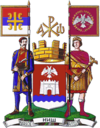Navissos
|
Niš Град Ниш |
|||
|---|---|---|---|
| City | |||
| City of Niš | |||

Niš and the Nišava River in August 2011
|
|||
|
|||
 Location of the city of Niš within Serbia |
|||
| Coordinates: 43°19′09″N 21°53′46″E / 43.31917°N 21.89611°E | |||
| Country |
|
||
| Region | Southern and Eastern Serbia | ||
| District | Nišava | ||
| Municipalities | 5 | ||
| First mention | 2nd century AD | ||
| Liberation from Ottomans | 11 January 1878 | ||
| Government | |||
| • Mayor of Niš | Darko Bulatović (SNS) | ||
| • Ruling parties | SNS | ||
| Area | |||
| • City | 597 km2 (231 sq mi) | ||
| Area rank | 51st | ||
| Elevation | 195 m (640 ft) | ||
| Population (2011) | |||
| • City |
|
||
| • Rank | 3rd | ||
| • Density | 435.9/km2 (1,129/sq mi) | ||
| • Urban |
|
||
| • Metro |
|
||
| Time zone | CET (UTC+1) | ||
| • Summer (DST) | CEST (UTC+2) | ||
| Postal code | 18000 | ||
| Area code(s) | +381(0)18 | ||
| ISO 3166 code | SRB | ||
| Car plates | NI | ||
| Website | www.ni.rs | ||
Niš (Serbian Cyrillic: Ниш, pronounced [nîːʃ]) is the third largest city of Serbia and the administrative center of the Nišava District in southern Serbia. According to the 2011 census, the city has population of 183,164, while urban area of Niš (with adjacent urban settlement of Niška Banja included) has 187,544 inhabitants; the administrative area has a population of 260,237.
It is one of the oldest cities in the Balkans and Europe, and has from ancient times been considered a gateway between the East and the West. It was founded by the Scordisci in 279 BC, after an invasion of the Balkans. The city was among several taken in the Roman conquest in 75 BC; the Romans built the Via Militaris in the 1st century, with Naissus being one of its key towns; it is also the birthplace of Constantine the Great, the first Christian Emperor and the founder of Constantinople, and Constantius III and Justin I. It is home to one of the oldest churches in Serbia, dating to the 4th century, located in the suburb of Mediana. The Balkans came under the Eastern Roman (Byzantine) Empire. In the 6th century, Slavs started settling the Balkans, while the town was held by the Byzantines until the 9th century, when it came under Bulgar rule. The town switched hands between the two, before being given by the Byzantines to the Serbs in the 12th century. Niš served as Stefan Nemanja's capital. It was conquered by the Ottomans in the 15th century, becoming the seat of a sanjak initially in Rumelia Eyalet (1385-1443, 1448-1846), laterly in Niš Eyalet (1846-1864) and finally in Danube Vilayet (1864-1878). It was liberated by the Serbian Army in 1878 during the Serbian–Ottoman War (1876–78).
...
Wikipedia


